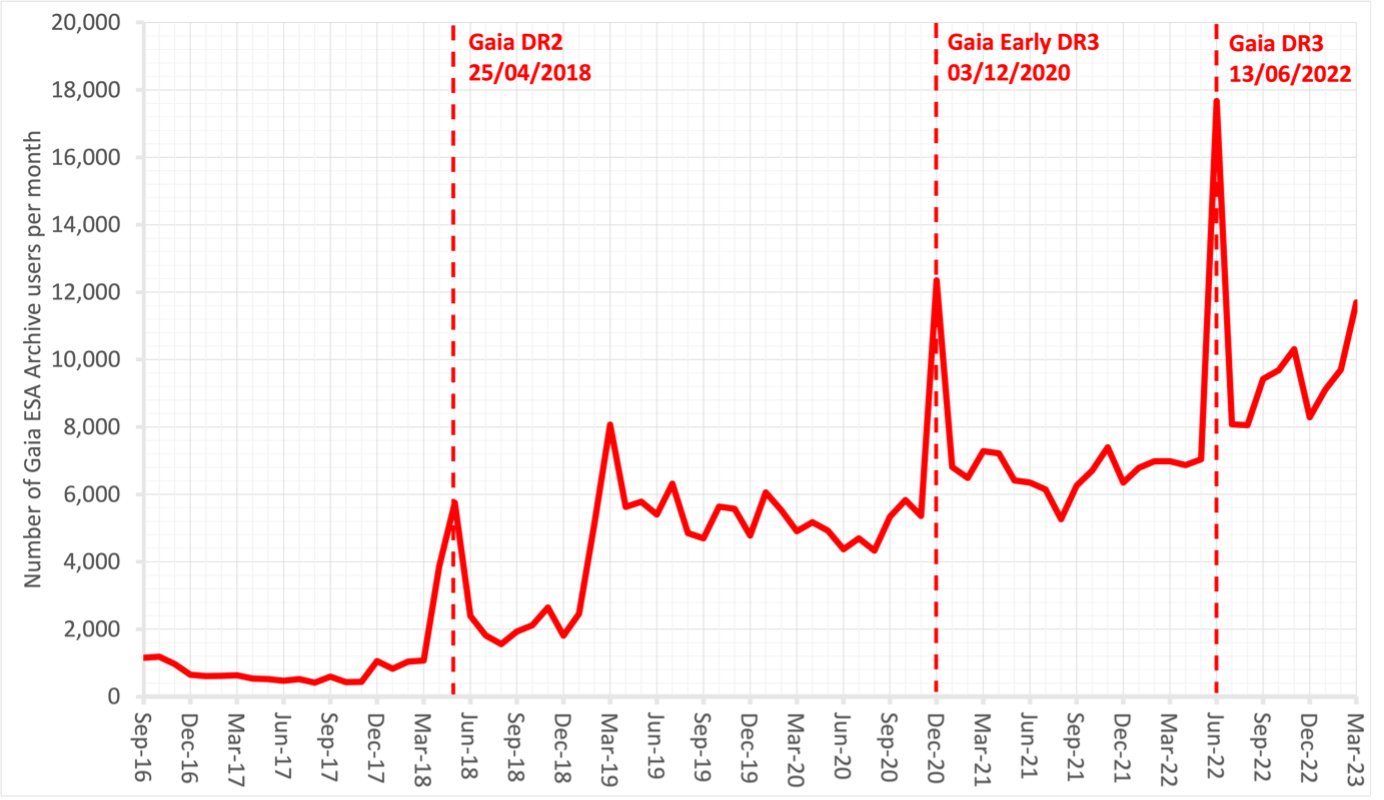IoW_20230425 - Gaia
Image of the Week
The Gaia ESA Archive
Figure 1. monthly number of unique users (unique IP addresses) of the Gaia ESA Archive starting in September 2016, coinciding with Gaia’s first data release (Gaia DR1). These statistics do not include access of Gaia data through the bulk download repository, or ESASky, or our partner and affiliate data centres. Image: ESA/ESDC. Credits: ESA/ESDC
Today, 25 April 2023, marks the fifth anniversary of the second Gaia Data Release (Gaia DR2). Gaia DR2 was revolutionary including more than 1300 million sources with five-parameter astrometry (position, parallax, and proper motion) as well as G, GBP, and GRP mean photometry, more than 7 million sources with radial velocities, more than half a million variable sources, stellar astrophysical parameter estimates for many tens of millions of sources, and epoch astrometry for more than 14 thousand known solar system objects. Based on these ground-breaking data, thousands of peer-reviewed publications have been published, among which five fascinating revelations about the Milky Way (see also this overview of science highlights from Gaia DR2).
Gaia’s data releases can be queried from the Gaia ESA Archive (GEA) at https://gea.esac.esa.int/archive/, as part of the ESAC Science Data Centre (ESDC). The above figure shows the evolution of the monthly number of users (unique IP addresses) of the Gaia ESA Archive between September 2016 and March 2023. It shows a (possibly step-wise) increasing trend with a number of clear peaks that match the data releases. There is one conspicuous peak in the spring of 2019 which has no clearly identified cause. The release notes of the Archive indicate that release 2.5 was made in February 2019, offering a new JOB_UPLOAD function, the RAVE DR5 catalogue, etc. This added functionality is possibly (partially) responsible for the observed increase of users, although it cannot be excluded that the root cause is different.
Needless to say: the Gaia ESA Archive is being developed for you, to ease data access as well as to safeguard the legacy value of the mission data. In other words: any feedback on the Archive and its services is more than welcome. Should our data release overview pages or our FAQs or our demos and tutorials not answer your question, please feel free to contact the Gaia helpdesk.
Credits: Story written by Jos de Bruijne (Gaia Archive Scientist), Héctor Cánovas (Gaia Support Archive Scientist, Telespazio UK for ESA), Pedro García-Lario (Community Support Scientist) and the Astronomy Survey Missions Archives Development Team (in alphabetical order): Tomás Alonso (RHEA Group for ESA), Pilar de Teodoro (Aurora Technology B.V. for ESA), Jorge Fernández (RHEA Group for ESA), Mónica Fernández (RHEA Group for ESA), Marcos López-Caniego (Aurora Technology B.V. for ESA), Sara Nieto (RHEA Group for ESA), Joaquim Oliveira (Aurora Technology B.V. for ESA), Paolo Pesciullesi (RHEA Group for ESA), Carlos Ríos (RHEA Group for ESA), and Pablo Turrión (RHEA Group for ESA).
[Published: 25/04/2023]
- Removed a total of (5) style text-align:center;
- Removed a total of (3) style text-align:justify;
Image of the Week Archive
- Removed a total of (1) border attribute.
- Removed a total of (1) cellpadding attribute.
- Removed a total of (1) cellspacing attribute.








































 Sign in
Sign in
 Science & Technology
Science & Technology
